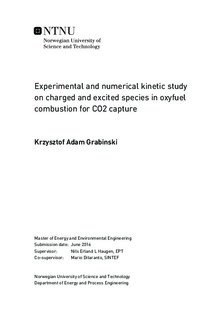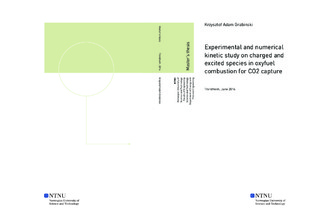| dc.description.abstract | Within the scope of the work, selected chemical kinetics and combustion
issues were investigated.
The first part contains a study of high temperature plasma and its po-
tential usage as a working fluid in the magnetohydrodynamic generator. The
well established GRI 3.0 mechanism for methane combustion has been ex-
tended to include electrons and ions from literature in order to evaluate the
effect of oxy-fuel combustion on the production of these, hence their potential
to generate a high enough conductivity for MHD applications. The results
show, however, that it is highly unlikely to obtain, in the industrial environ-
ment, naturally ionized plasma that could be applied as a working fluid in
the effective MHD generator. Electron and ion concentration that defines
electrical conductivity of the fluid is simply not high enough. In other words
- without additional seeding that increases electrical conductivity, it would
be very problematic (and expensive) for the MHD generator to function with
naturally ionized combustion gasses. The pressure and temperature required
to obtain naturally ionized plasma characterized by adequate parameters for
the magnetohydrodynamic power plant are beyond the present industrial
possibilities.
The second part describes a chemiluminescence study of the excited species
in various flame types. In this section of the work the previous mechanism
has been further extended to include chemiluminescence reactions for OH*,
CH* and CO 2 * from different literature sources. The mechanism has been
validated against experiments in both premixed and diffusion flame config-
urations. The obtained mechanism can be used to assess the potential for
monitoring flames in oxy-fuel conditions. Conducted measurements proves
the accuracy of the created mechanism in case of OH*, CH* and provides a
groundwork for the future studies of chemiluminescence phenomena.
The second part describes a chemiluminescence study of the excited species in various flame types. Many different variants of combustion mechanisms involving excited species were investigated, resulting in one, consistent set of reactions for chemically excited CH , OH and CO2. Conducted measurements prove the accuracy of the created mechanism and provides a groundwork for the future studies of chemiluminescence phenomena. | |

